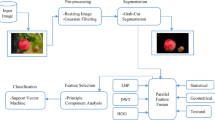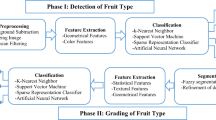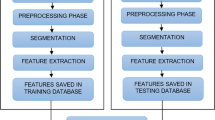Abstract
Post-harvest grading is an essential and important process that affects the fruit quality, evaluation, health-intensive, and export market. Even though the sorting and grading can be performed by the human as going on, it is tedious, labor-intensive, slow, and error-prone. Hence, smart automation is required for the same. Computer vision advancements touching every area where there even a minimal chance of smart automation. In this paper, intelligent automation for mango fruit grading designed and developed. Initially, the fruit segmentation is done by the active contour model, and the abnormality segmentation is performed using enhanced fuzzy-based K-means clustering approach followed by features: discrete Fourier transform (DFT), local binary pattern (LBP), and gray-level co-occurrence matrix (GLCM) and shape features extraction. The self-adaptive chicken swarm optimization (SA-CSO) has been used to reduce and optimize features vector. The quality of the fruits has finally categorized based on surface defect and maturity classification. Hence, for defect classifications, optimal abnormality segmented features have been fed to the K-nearest neighbors (KNN). The optimally selected fruit segmented features are subjected to a fuzzy classifier and the fruit segmented images are subjected to a convolutional neural network (CNN). As an improvement, the proposed SA-CSO is used to optimize the hybrid classifier for maximizing the accuracy of classification. The maturity is classified using the hybrid fuzzy classifier and CNN as ripe, partially ripe, and unripe. Finally, the defect and maturity output have been used to decide the quality as good, average, and bad. The comparative analysis of diverse performance metrics proves the effectiveness of the proposed model over other traditional algorithms.









Similar content being viewed by others
Abbreviations
- CVSs:
-
Computer vision systems
- CNN:
-
Convolutional neural networks
- EQA:
-
Effective quality assessment
- MCC:
-
Mathews correlation coefficient
- FPR:
-
False positive rate
- ANN:
-
Artificial neural networks
- FDR:
-
False discovery rate
- LBP:
-
Local binary pattern
- FNR:
-
False negative rate
- MADM:
-
Multi-attribute decision making
- CLAHE:
-
Contrast limited adaptive histogram equalization
- JPEG:
-
Joint Photographic Experts Group
- KNN:
-
K-nearest neighbor
- GLCM:
-
Gray-level co-occurrence matrix
- DFT:
-
Discrete Fourier transform
- RGB:
-
Red Green Blue
- PSO:
-
Particle swarm optimization
- NPV:
-
Negative predictive value
- SVM:
-
Support vector machine
References
Arun Kumar R, Rajpurohit VS, Bidari KY (2019) Multi class grading and quality assessment of pomegranate fruits based on physical and visual parameters. Int J Fruit Sci 19(4):372–396
Castro W, Oblitas J, De-La-Torre M, Cotrina C, Bazán K, Avila-George H (2019) Classification of cape gooseberry fruit according to its level of ripeness using machine learning techniques and different color spaces. IEEE Access 7:27389–27400
Kaur H, Sawhney BK, Jawandha SK (2018) Evaluation of plum fruit maturity by image processing techniques. J Food Sci Technol 55:3008–3015
Nasiri A, Taheri-Garavand A, Zhang Y-D (2019) Image-based deep learning automated sorting of date fruit. Postharvest Biol Technol 153:133–141
Ren A et al (2020) Machine learning driven approach towards the quality assessment of fresh fruits using non-invasive sensing. IEEE Sens J 20(4):2075–2083
Matteoli S, Diani M, Massai R, Corsini G, Remorini D (2015) A Spectroscopy-based approach for automated nondestructive maturity grading of peach fruits. IEEE Sens J 15(10):5455–5464
Nandi CS, Tudu B, Koley C (2016) A machine vision technique for grading of harvested mangoes based on maturity and quality. IEEE Sens J 16(16):6387–6396
Marimuthu S, Roomi SMM (2017) Particle swarm optimized fuzzy model for the classification of banana ripeness. IEEE Sens J 17(15):4903–4915
Liew OW, Chong PCJ, Li B, Asundi AK (2008) Signature optical cues: emerging technologies for monitoring plant health. Sensors (Basel) 8(5):3205–3239
Wang H, Peng J, Xie C, Bao Y, He Y (2015) Fruit quality evaluation using spectroscopy technology: a review. Sensors (Basel) 15(5):11889–11927
Ren A, Zahid A, Fan D, Yang X, AliImran M, Alomainy A, Abbasi QH (2019) State-of-the-art in terahertz sensing for food and water security – a comprehensive review. Trends Food Sci Technol 85:241–251
Liakos KG, Busato P, Moshou D, Pearson S, Bochtis D (2018) Machine learning in agriculture: a review. Sensors (Basel) 18(8):2674
Zhang B, Huang W, Li J, Zhao C, Fan S, Wu J, Liu C (2014) Principles, developments and applications of computer vision for external quality inspection of fruits and vegetables: a review. Food Res Int 62:326–343
Arakeri MP, Lakshmana A (2016) Computer vision based fruit grading system for quality evaluation of tomato in agriculture industry. Procedia Comput Sci. 79:426–433
Chen K, Sun X, Qin C, Tang X (2010) ‘Color grading of beef fat by using computer vision and support vector machine.’ Comput Electron Agricult 70(1):27–32
Romano G, Argyropoulos D, Nagle M, Khan MT, Müller J (2012) Combination of digital images and laser light to predict moisture content and color of bell pepper simultaneously during drying. J Food Eng 109(3):438–448
Brosnan T, Sun D-W (2004) Improving quality inspection of food products by computer vision––a review. J Food Eng 61(1):3–16
Castro W, Oblitas J, Chuquizuta T, Avila-George H (2017) Application of image analysis to optimization of the bread-making process based on the acceptability of the crust color. J Cereal Sci 74:194–199
Oliveira SF, Gonçalves FJA, Correia PMR, Guiné RPF (2016) Physical properties of Physal is peruviana L. Open Agric. 1(1):55–59
Guerrero ER, Benavides GM (2014) Automated system for classifying Hass avocados based on image processing techniques. In: Proceedings of. IEEE colombian conference communication computing, pp. 1–6.
LeCun Y, Bengio Y, Hinton G (2015) Deep learning. Nature 521(7553):436–444
Amara J, Bouaziz B, Algergawy A (2017) A deep learning-based approach for banana leaf diseases classification, Workshopband.
Chen SW et al (2017) Counting apples and oranges with deep learning: a data-driven approach. IEEE Robot Autom Lett 2(2):781–788
Lee SH, Chan CS, Wilkin P, Remagnino P (2015) Deep-plant: Plant identification with convolutional neural networks, In: 2015 IEEE international conference on image processing (ICIP), Quebec City, QC, pp. 452–456.
Nandi CS, Tudu B, Koley C (2014) A machine vision-based maturity prediction system for sorting of harvested mangoes. IEEE Trans Instrum Meas 63(7):1722–1730
Meng X, Liu Y, Gao X, Zhang H (2014) A new bio-inspired algorithm: chicken swarm optimization, In: International conference in swarm intelligence, advances in swarm intelligence, pp 86–94.
Rajakumar BR (2013) Impact of static and adaptive mutation techniques on genetic algorithm. Int J Hybrid Intell Syst 10(1):11–22
Rajakumar BR (2013) Static and adaptive mutation techniques for genetic algorithm: a systematic comparative analysis. Int J Comput Sci Eng 8(2):180–193
Patil RS, Biradar N (2020) Automated mammogram breast cancer detection using the optimized combination of convolutional and recurrent neural network. Evol Intel. https://doi.org/10.1007/s12065-020-00403-x
Murala S, Jonathan Wu QM (2014) Local mesh patterns versus local binary patterns: biomedical image indexing and retrieval, IEEE J Biomed Health Inform, 18(3).
Rawat W, Wang Z (2017) Deep convolutional neural networks for image classification: a comprehensive review, Neural Comput, 29.
Patil RS, Biradar N (2020) Improved region growing segmentation for breast cancer detection: progression of optimized fuzzy classifier, Int J Intell Comput Cybern, 13(2).
Sim KS, Chia FK, Nia ME, Tso CP, Chong AK, Abbas SF, Chong SS (2014) Breast cancer detection from MR images through an auto-probing discrete Fourier transform system. Comput Biol Med 49:46–59
Jose A, Ravi S, Sambath M (2014) Brain tumor segmentation using K-means clustering and fuzzy c-means algorithm and its area calculation, In: Int J Innov Res Comput Commun Eng, 2(2).
Dhanachandra N, Manglem K, Chanu YJ (2015) Image segmentation using K-means clustering algorithm and subtractive clustering algorithm. Procedia Comput Sci 54:764–771
Ma J, Fan X, Yang SX, Zhang X, Zhu X (2017) Contrast limited adaptive histogram equalization based fusion in YIQ and HSI color spaces for underwater image enhancement, Int J Pattern Recogn Artif Intell.
Guo Y, Han S, Li Y, Zhang C, Bai Y (2018) K-nearest neighbor combined with guided filter for hyperspectral image classification. Procedia Comput Sci 129:159–165
Cruz-Aceves I, Avina-Cervantes JG, Lopez-Hernandez JM, Garcia-Hernandez MG, Torres-Cisneros M, Estrada-Garcia HJ, Hernandez-Aguirre A (2013) Automatic image segmentation using active contours with univariate marginal distribution, Math Prob Eng.
Bonyadi MR, Michalewicz Z (2016) Analysis of stability, local convergence, and transformation sensitivity of a variant of the particle swarm optimization algorithm. IEEE Trans Evol Comput 20(3):370–385
Mirjalili S, Lewis A (2016) The whale optimization algorithm. Adv Eng Softw 95:51–67
Mirjalili S, Mirjalili SM, Hatamlou A (2016) Multi-verse optimizer: a nature-inspired algorithm for global optimization. Neural Comput Appl 27:495–513
Wu D et al (2016) Deep dynamic neural networks for multimodal gesture segmentation and recognition. IEEE Trans Pattern Anal Mach Intell 38(8):1583–1597
Wu J, Yang H (2015) Linear regression-based efficient SVM learning for large-scale classification. IEEE Trans Neural Netw Learn Syst 26(10):2357–2369
Tsang S, Kao B, Yip KY, Ho W, Lee SD (2011) Decision trees for uncertain data. IEEE Trans Knowl Data Eng 23(1):64–78
Recce M, Taylor J, Piebe A, Tropiano G (1996) High speed vision-based quality grading of oranges, In: Proceedings of international workshop on neural networks for identification, control, robotics and signal/image processing, pp 136–144, doi: https://doi.org/10.1109/NICRSP.1996.542754.
Njoroge JB, Ninomiya K, Kondo N, Toita H (2002) Automated fruit grading system using image processing, In: Proceedings of the 41st SICE annual conference. SICE 2002., pp. 1346–1351, vol. 2, doi: https://doi.org/10.1109/SICE.2002.1195388.
Chherawala Y, Lepage R, Doyon G (2006) Food grading/sorting based on color appearance trough machine vision: the case of fresh cranberries, In: 2006 2nd international conference on information & communication technologies, pp. 1540–1545, doi: https://doi.org/10.1109/ICTTA.2006.1684612.
Lee D, Archibald JK, Xiong G (2011) Rapid color grading for fruit quality evaluation using direct color mapping. IEEE Trans Autom Sci Eng 8(2):292–302. https://doi.org/10.1109/TASE.2010.2087325
Author information
Authors and Affiliations
Corresponding author
Ethics declarations
Conflict of interest
There is no conflict of interest from authors’ side.
Additional information
Publisher's Note
Springer Nature remains neutral with regard to jurisdictional claims in published maps and institutional affiliations.
Rights and permissions
About this article
Cite this article
Kumari, N., Dwivedi, R.K., Bhatt, A.K. et al. Automated fruit grading using optimal feature selection and hybrid classification by self-adaptive chicken swarm optimization: grading of mango. Neural Comput & Applic 34, 1285–1306 (2022). https://doi.org/10.1007/s00521-021-06473-x
Received:
Accepted:
Published:
Issue Date:
DOI: https://doi.org/10.1007/s00521-021-06473-x




